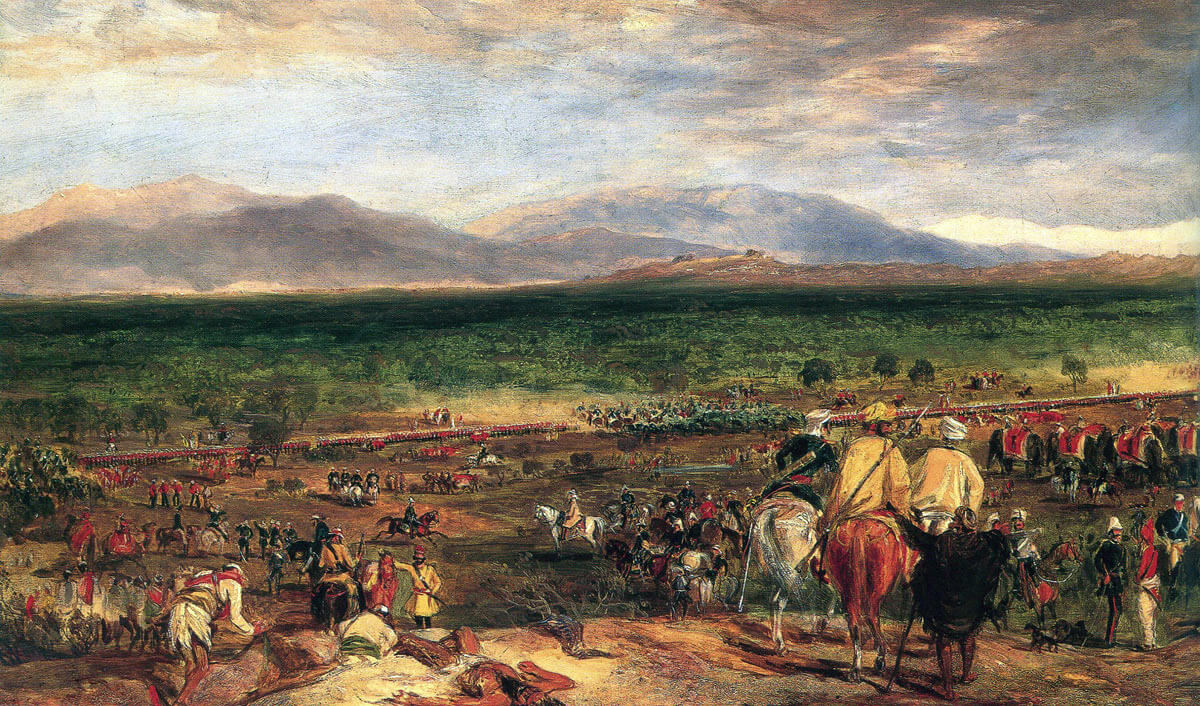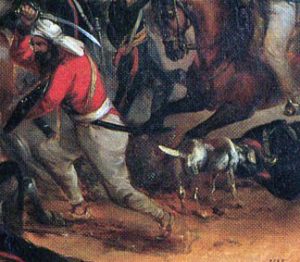The battle of the Second Sikh War fought on 13th January 1849, notorious in early Victorian Britain and India for the conduct of Brigadier Pope’s brigade of light cavalry
The previous battle in the Second Sikh War is the Battle of Ramnagar
The next battle in the Second Sikh War is the Battle of Goojerat
Battle: Chillianwallah.
War: Second Sikh War.
Date of the Battle of Chillianwallah: 13th January 1849.
Place of the Battle of Chillianwallah: In the Punjab in the North-West of India.
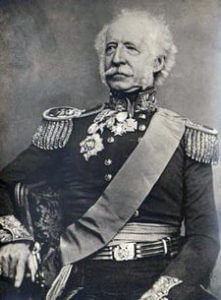
Major General Sir Hugh Gough, British commander at the Battle of Chillianwallah on 13th January 1849 during the Second Sikh War
Combatants at the Battle of Chillianwallah: British troops and Indian troops of the Bengal Presidency against Sikhs of the Khalsa, the army of the Punjab.
Commanders at the Battle of Chillianwallah: Major General Sir Hugh Gough against the Sikh general, Shere Singh.
Size of the armies at the Battle of Chillianwallah: 12,000 British and Bengalis with 66 guns against 35,000 Sikhs with 65 guns.
Uniforms, arms and equipment at the Battle of Chillianwallah (this section is the same in each of the battles of the Sikh Wars):
The two wars fought between 1845 and 1849 between the British and the Sikhs led to the annexation of the Punjab by the British East India Company, and one of the most successful military co-operations between two races, stretching into a century of strife on the North West Frontier of British India, the Indian Mutiny, Egypt and finally the First and Second World Wars.
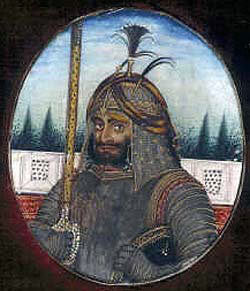
Shere Singh, Sikh commander at the Battle of Chillianwallah on 13th January 1849 during the Second Sikh War
The British contingent comprised four light cavalry regiments (3rd, 9th, 14th and 16th Light Dragoons- the 9th and 16th being lancers) and twelve regiments of foot (9th, 10th, 24th, 29th, 31st, 32nd, 50th, 53rd, 60th, 61st, 62nd and 80th regiments).
The bulk of General Gough’s ‘Army of the Sutlej’ in the First Sikh War and ‘Army of the Punjab’ in the Second Sikh War comprised regiments from the Bengal Presidency’s army: 9 regular cavalry regiments (the Governor-General’s Bodyguard and 1st, 3rd, 4th, 5th, 6th, 7th, 8th and 11th Bengal Light Cavalry), 13 regiments of irregular cavalry (2nd, 3rd, 4th, 7th to 9th and 11th to the 17th Bengal Irregular Cavalry), 48 regiments of foot (1st to 4th, 7th, 8th, 12th to 16th, 18th, 20th, 22nd, 24th to 27th, 29th to 33rd, 36th, 37th, 41st to 54th, 56th, 59th, 63rd and 68th to 73rd Bengal Native Infantry), horse artillery, field artillery, heavy artillery and sappers and miners.
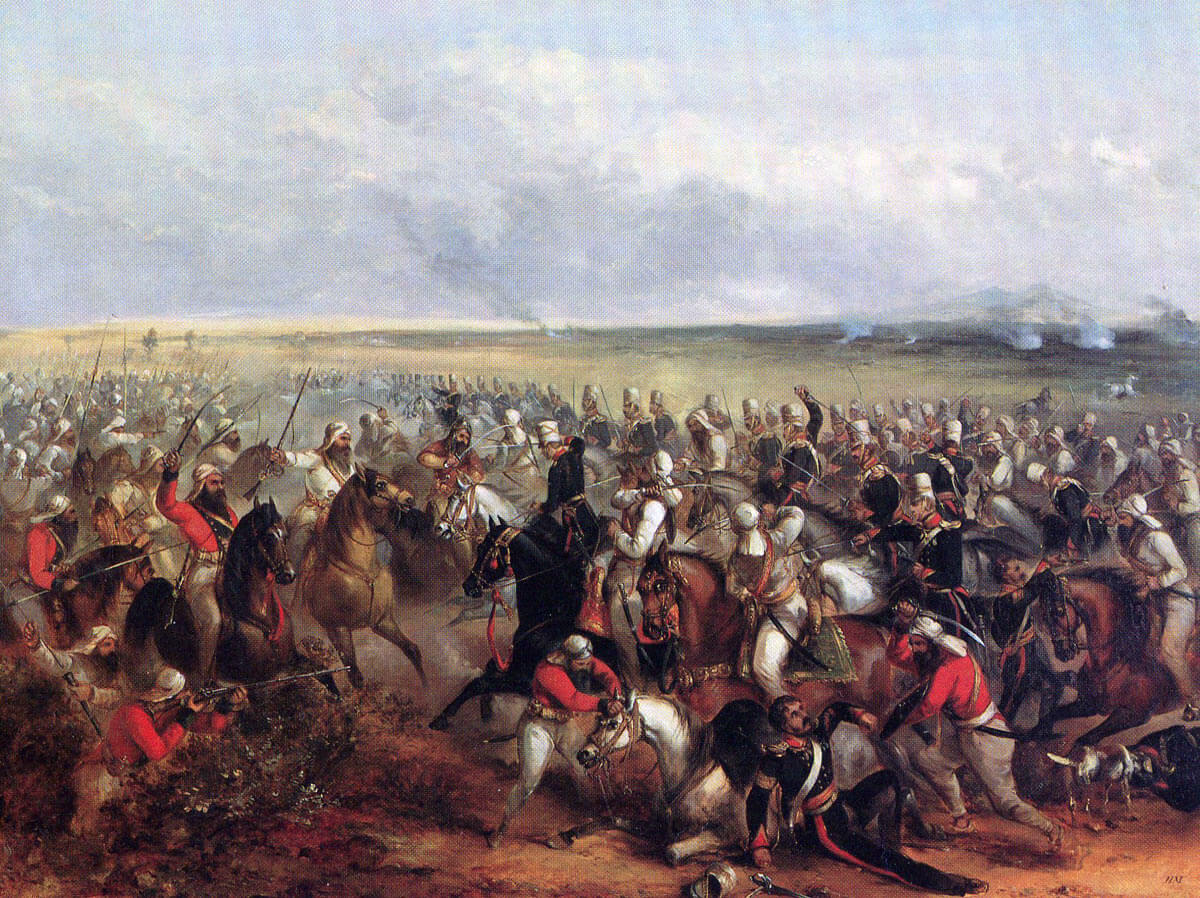
3rd King’s Own Light Dragoons at the Battle of Chillianwallah on 13th January 1849 during the Second Sikh War
The Bombay presidency contributed a force that marched in from Scinde, in the west, and gave considerable assistance at the Siege of Multan; the 19th Bombay Native Infantry gaining the title of the Multan Regiment for its services in the siege, a label still held by its Indian Army successor.
A Bombay brigade under Brigadier Dundas joined General Gough’s army for the final battle of the Second Sikh War at Goojerat, where the two regiments of Scinde Horse, Bombay Irregular Cavalry, particularly distinguished themselves. The brigade comprised: 2 regiments of Scinde Horse, 3rd and 19th Bombay Native Infantry and Bombay horse artillery and field artillery.
Each of the three presidencies, in addition to their native regiments, possessed European infantry, of which the 1st Bengal (European) Infantry, 2nd Bengal (European) Light Infantry and 1st Bombay (European) Fusiliers took part in the Sikh Wars.
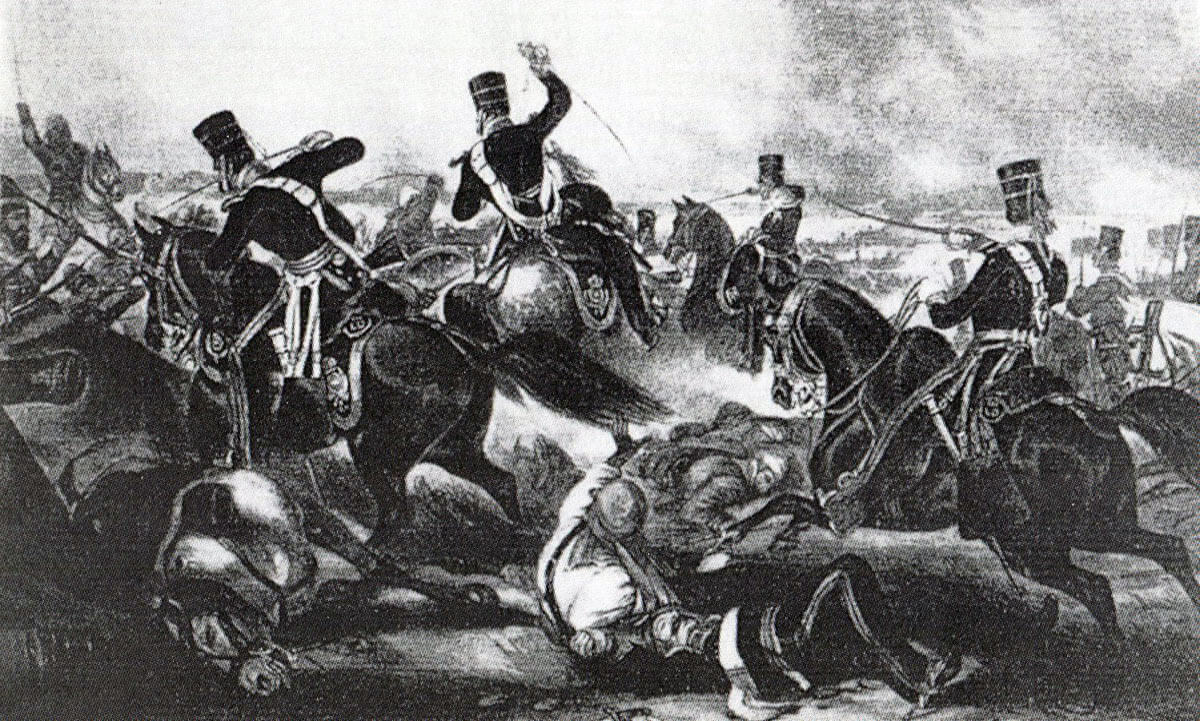
3rd King’s Own Light Dragoons at the Battle of Chillianwallah on 13th January 1849 during the Second Sikh War
Other corps fought under the British flag, such as the Shekawati cavalry and infantry and the first two Gurkha regiments: the Nasiri Battalion (later 1st Gurkhas) and the Sirmoor Battalion (later 2nd Gurkhas).
General Gough commanded the British/Indian army at six of the seven major battles (not the Battle of Aliwal). An Irishman, Gough was immensely popular with his soldiers, for whose welfare he was constantly solicitous. The troops admired Gough’s bravery, in action wearing a conspicuous white coat, which he called his ‘Battle Coat’, so that he might draw fire away from his soldiers.
Gough’s tactics were heavily criticised, even in the Indian press in letters written by his own officers. At the Battles of Moodkee, Sobraon and Chillianwallah, Gough launched headlong attacks, considered to be ill-thought out by many of his contemporaries. Casualties were high and excited concern in Britain and India. By contrast, Gough’s final battle, Goojerat, which decisively won the war, cost few of his soldiers their lives and was considered a model of care and planning.
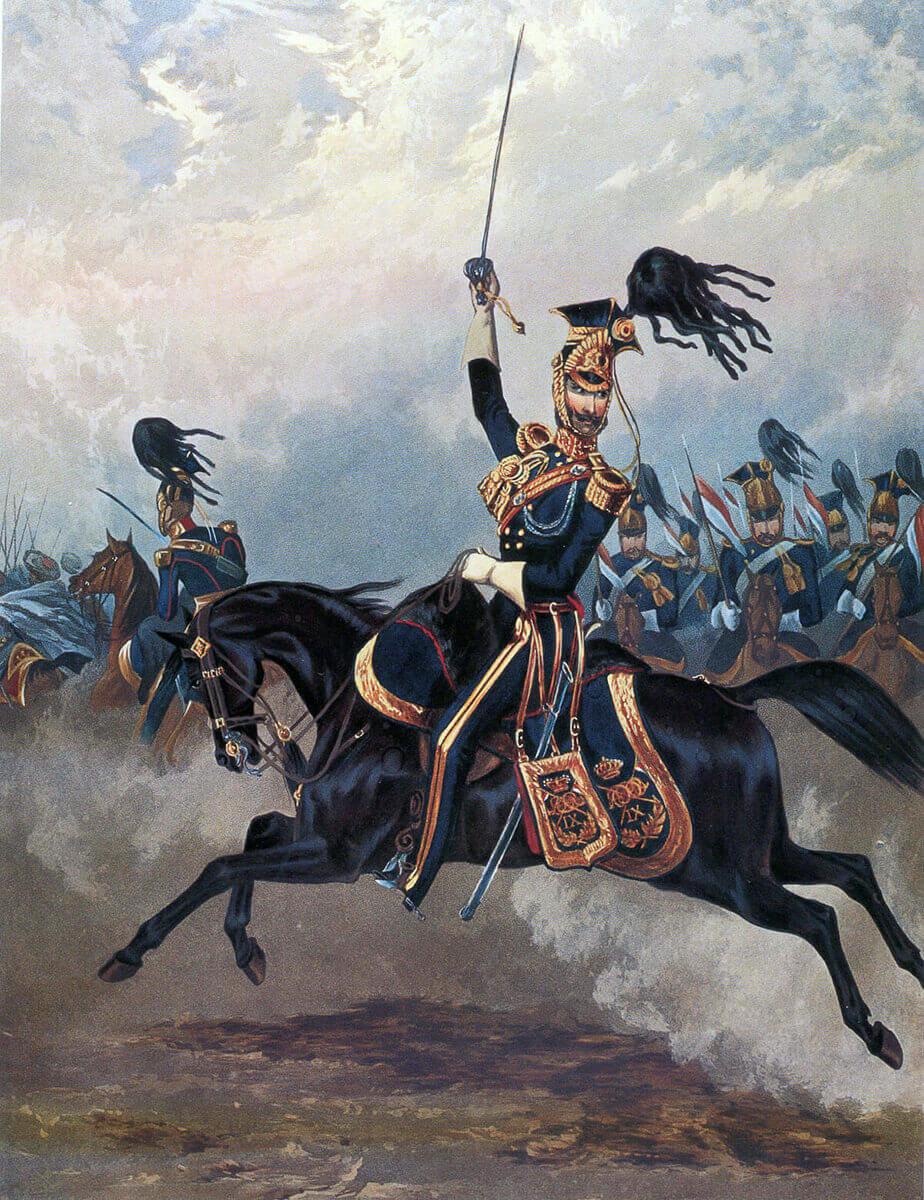
9th Queen’s Royal Lancers: Battle of Chillianwallah on 13th January 1849 during the Second Sikh War: print by Ackermann
Every battle saw vigorous cavalry actions, with HM 3rd King’s Own Light Dragoons and HM 16th Queen’s Lancers particularly distinguishing themselves. The British light cavalry wore embroidered dark blue jackets and dark blue overall trousers, except the 16th who bore the sobriquet ‘the Scarlet Lancers’ for their red jackets. The headgear of the two regiments of light dragoons was a shako with a white cover; the headgear of the lancers the traditional Polish tschapka.
HM regiments of foot wore red coats and blue trousers with shakos and white covers.
The Bengal and Bombay light cavalry regiments wore pale blue uniforms. The infantry of the presidency armies wore red coats and peak less black shakos.
The weapons for the cavalry were the lance for the lancer regiments and sword and carbine for all; the infantry was armed with the Brown Bess musket and bayonet.
Commands in the field were given by the cavalry trumpet and the infantry drum and bugle.
In the initial battles, the Sikh artillery outgunned Gough’s batteries. Even in these battles and in the later ones, the Bengal and Bombay horse and field artillery were handled with great resource and were a major cause of Gough’s success.
Many of the more senior British officers had cut their military teeth in the Peninsular War, and at the Battle of Waterloo: Gough, Hardinge, Havelock of the 14th Light Dragoons, Cureton, Dick, Thackwell and others. Many of the younger men would go on to fight in the Crimea and the Indian Mutiny.
The Sikhs of the Punjab looked to the sequence of Gurus for their spiritual inspiration, and had established their independence, fiercely resisting the Moghul Kings in Delhi and the Muslims of Afghanistan. The Sikhs were required by their religion to wear the ‘five Ks’, not to cut their hair or beard and to wear the highly characteristic turban, a length of cloth in which the hair is wrapped around the head.
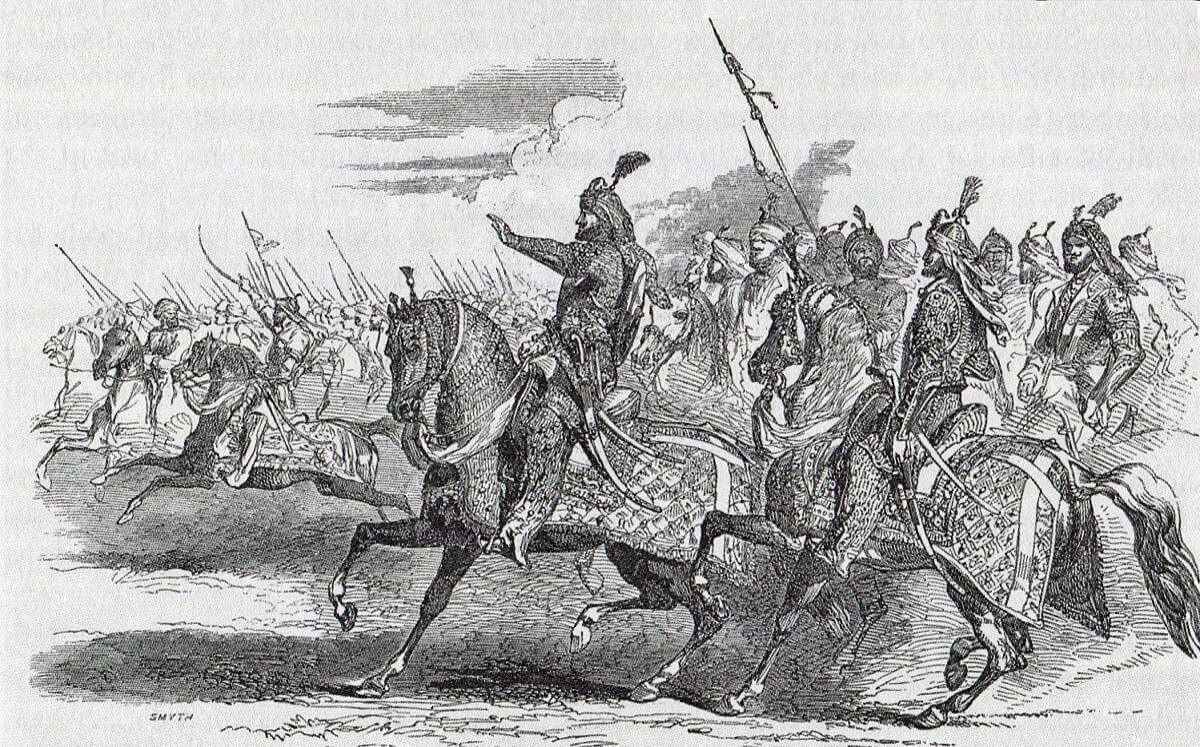
Shere Singh, Sikh commander with his escort at the Battle of Chillianwallah on 13th January 1849 during the Second Sikh War
The Maharajah of the Punjab, Ranjit Singh, whose death in 1839 ended the Sikh embargo on war with the British, established and built up the powerful Sikh Army, the ‘Khalsa’, over the twenty years of his reign. The core of the ‘Khalsa’ was its body of infantry regiments, equipped and trained as European troops, wearing red jackets and blue trousers. The Sikh artillery was held in high esteem by both sides. The weakness in the Sikh army was its horse. The regular cavalry regiments never reached a standard comparable to the Sikh foot, while the main element of the mounted arm comprised clouds of irregular and ill-disciplined ‘Gorcharras’.
The traditional weapon of the Sikh warrior is the ‘Kirpan’, a curved sword kept razor sharp and one of the ‘five Ks’ a baptised Sikh must wear. In battle, at the first opportunity, many of the Sikh foot abandoned their muskets and, joining their mounted comrades, engaged in hand to hand combat with sword and shield. Horrific cutting wounds, severing limbs and heads, were a feature of the Sikh Wars, in which neither side gave quarter to the enemy.
It had taken the towering personality of Ranjit Singh to control the turbulent ‘Khalsa’, he had established. Ranjit Singh’s descendants found the task beyond them and did much to provoke the outbreak of the First Sikh War, in the hope that the Khalsa would be cut down to size by the armies of the British East India Company. The commanders of the Sikh armies in the field rarely took the initiative in battle, preferring to occupy a fortified position and wait for the British and Bengalis to attack. In the opening stages of the war there was correspondence between Lal Singh and the British officer, Major Nicholson, suggesting that the Sikhs were being betrayed by their commander.
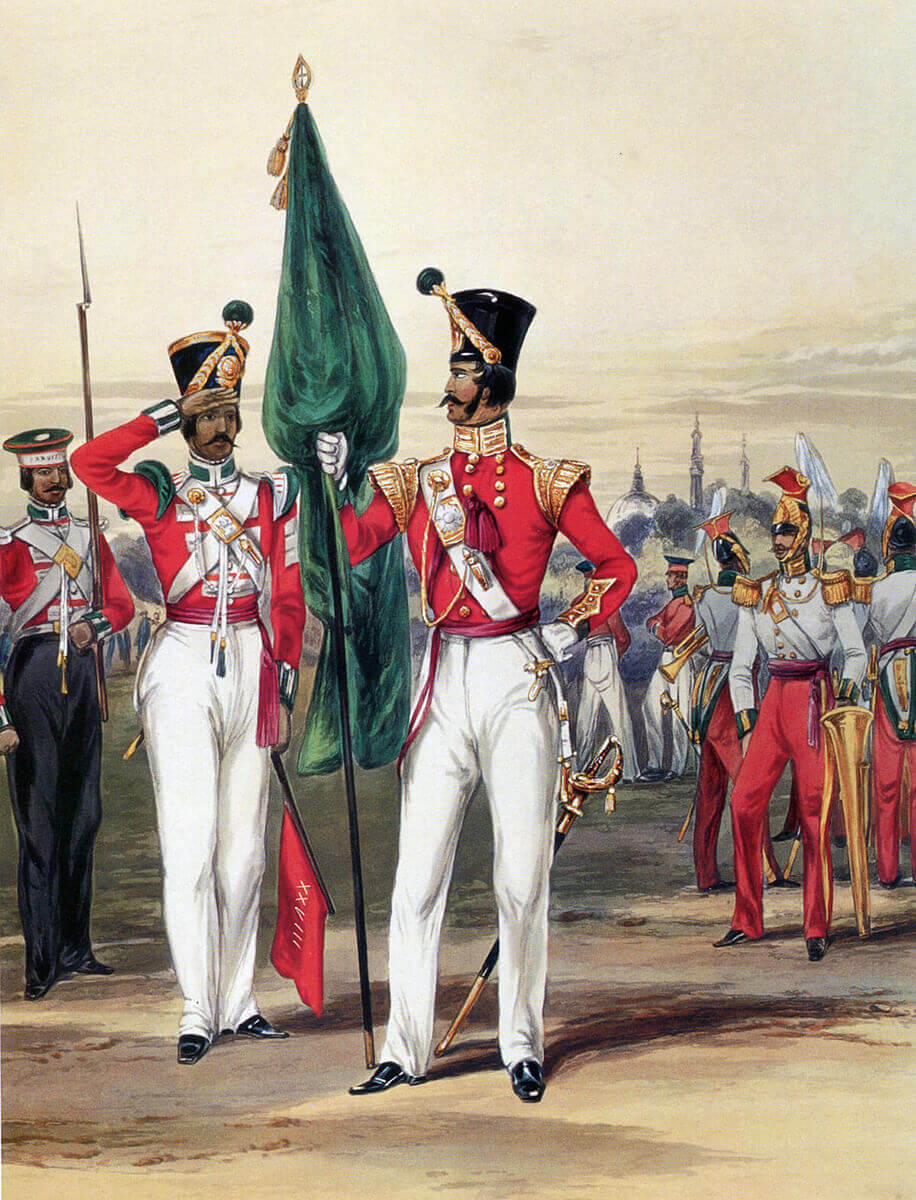
Bengal Native Infantry: Battle of Chillianwallah on 13th January 1849 during the Second Sikh War: print by Ackermann
Pay in the Khalsa was good, twice the rate for sepoys in the Bengal Army, but it was haphazard, particularly after the death of Ranjit Singh. Khalsa administration was conducted by clerks writing in the Persian language. In one notorious mutiny over pay, Sikh soldiers ran riot looking for anyone who could, or looked as if they could, speak Persian, and putting them to the sword.
The seven battles of the war and the siege of the city of Multan were hard fought. Several of the battle fields were wide flat spaces broken by jungly scrub, from which the movement of large bodies of troops in scorching heat raised choking clouds of dust. As the fighting began, the dust clouds intermingled with dense volumes of musket and cannon smoke. With the thunder of gunfire and horses’ hooves, the battle yells and cries of the injured, the battles of the Sikh Wars were indeed infernos.
Winner: Gough’s Army of the Punjab withdrew to its camp at Chillianwallah, while the Sikhs fell back no further than the hills around Rasul. The battle was not won by either side, although it is said that the Sikh missed an opportunity to defeat the British outright.
British and Indian Regiments at the Battle of Chillianwallah:
British Regiments:
HM 3rd King’s Own Light Dragoons, now the Queen’s Royal Hussars. *
HM 9th Queen’s Royal Light Dragoons (Lancers), now the 9th/12th Royal Lancers. *
HM 14th the King’s Light Dragoons, now the King’s Royal Hussars. *
HM 24th Foot, later the South Wales Borderers and now the Royal Welsh Regiment. *
HM 29th Foot, later the Worcestershire Regiment and now the Worcestershire and Sherwood Foresters Regiment. *
HM 61st Foot, later the Wiltshire Regiment and now the Royal Gloucestershire, Berkshire and Wiltshire Regiment. *
Bengal Army:
1st Bengal Light Cavalry.*
5th Bengal Light Cavalry.*
6th Bengal Light Cavalry.*
9th Bengal Light Cavalry.*
2nd European Light Infantry.*
6th Bengal Native Infantry.*
15th Bengal Native Infantry.*
20th Bengal Native Infantry.*
25th Bengal Native Infantry.*
30th Bengal Native Infantry.*
31st Bengal Native Infantry.*
36th Bengal Native Infantry.*
45th Bengal Native Infantry.*
46th Bengal Native Infantry.*
56th Bengal Native Infantry.*
69th Bengal Native Infantry.*
70th Bengal Native Infantry.*
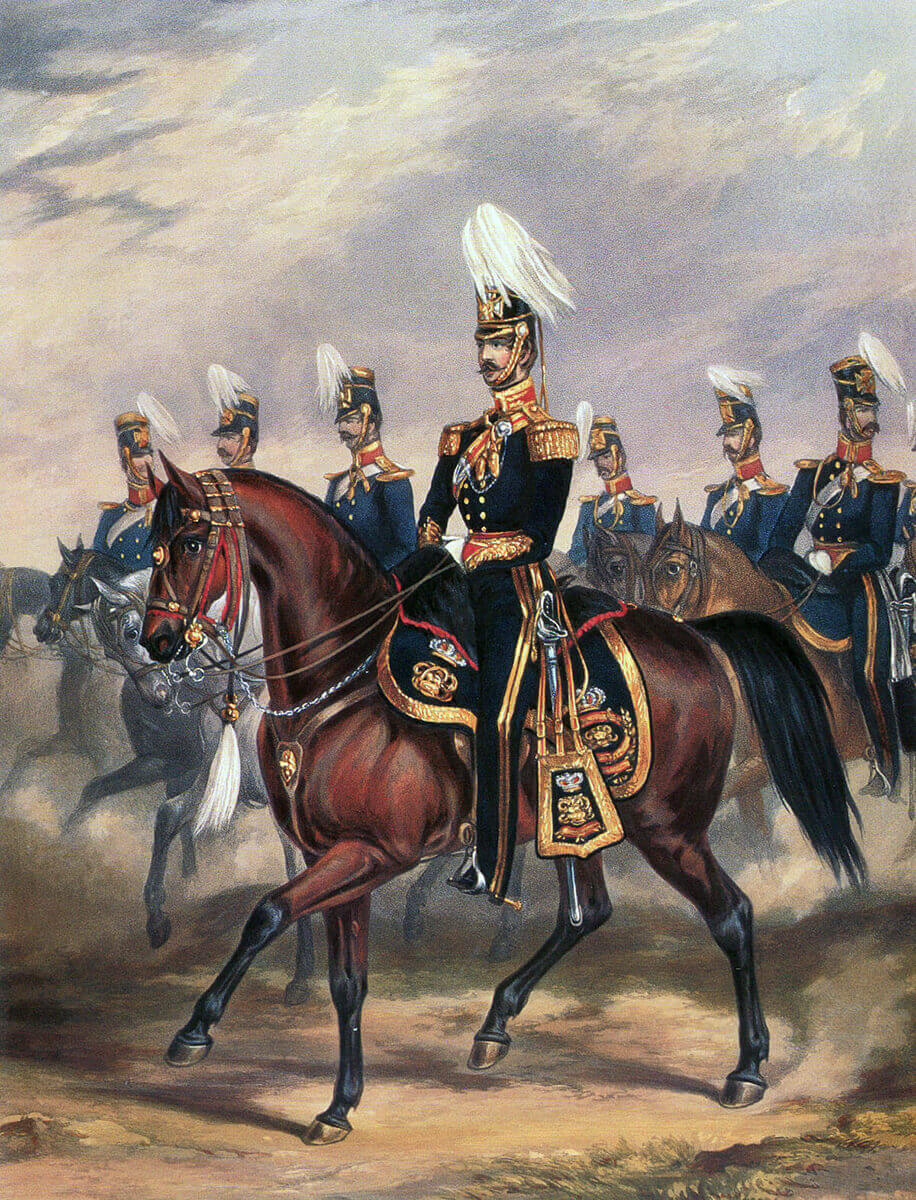
HM 14th Light Dragoons: Battle of Chillianwallah on 13th January 1849 during the Second Sikh War: print by Ackermann
Cavalry:
All the Bengal cavalry regiments that fought at Chillianwallah ceased to exist in 1857.
Infantry:
2nd Bengal (European) Light Infantry from 1861 102nd Light Infantry, from 1880 the Munster Fusiliers, disbanded in 1922.*
31st Bengal Native Infantry in1861 became the 2nd Bengal Light Infantry, in 1903 2nd (Queen’s Own) Rajput Light Infantry, in 1922 1st (Queen Victoria’s Own) Light Infantry Bn. 7th Rajput Regiment and in 1947 became 4th Bn. the Brigade of the Guards of the Indian Army.*
70th Bengal Native Infantry from 1861 11th Bengal Native Infantry, from 1903 11th Rajputs, from 1922 5th Battalion 7th Rajput Regiment and from 1947 5th Battalion, the Rajput Regiment of the Indian Army.*
The remaining Bengal infantry regiments that fought at Chillianwallah ceased to exist in 1857.
* These regiments have or had Chillianwallah as a battle honour.
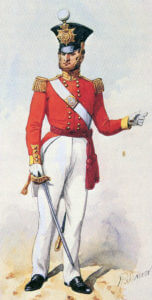
Officer of HM 29th Regiment: Battle of Chillianwallah on 13th January 1849 during the Second Sikh War: print by Richard Simkin
Order of Battle of the Army of the Punjab at the Battle of Chillianwallah:
Commander-in-chief: Major General Sir Hugh Gough.
Cavalry Division: Major General Sir Joseph Thackwell.
1st Brigade: Brigadier White; HM 3rd LD, 5th and 8th BLC.
2nd Brigade: Brigadier Pope; HM 9th Lancers, HM 14th LD, 1st and 6th BLC.
1st Infantry Division: General Gilbert.
1st Brigade: Brigadier Mountain; HM 29th Foot, 30th and 56th BNI.
2nd Brigade: Brigadier Godby; 2nd European LI, 31st and 70th BNI.
2nd Infantry Division: Brigadier Colin Campbell.
1st Brigade: Brigadier Pennycuick; HM 24th Foot, 25th and 45th BNI.
2nd Brigade: Brigadier Hoggan; HM 61st Foot, 6th, 36th and 46th BNI.
3rd Brigade: Brigadier Penny; 15th, 20th and 69th BNI.
Six horse batteries: Major General Brooke.
1st Brigade: Grant; Lane, Christie, Huish,
2nd Brigade: Brind; Warner, Duncan and Fordyce.
Three field batteries: Mowatt, Robertson and Dawes.
Two heavy batteries: Major Horsford, Captains Shakespeare and Ludlow.
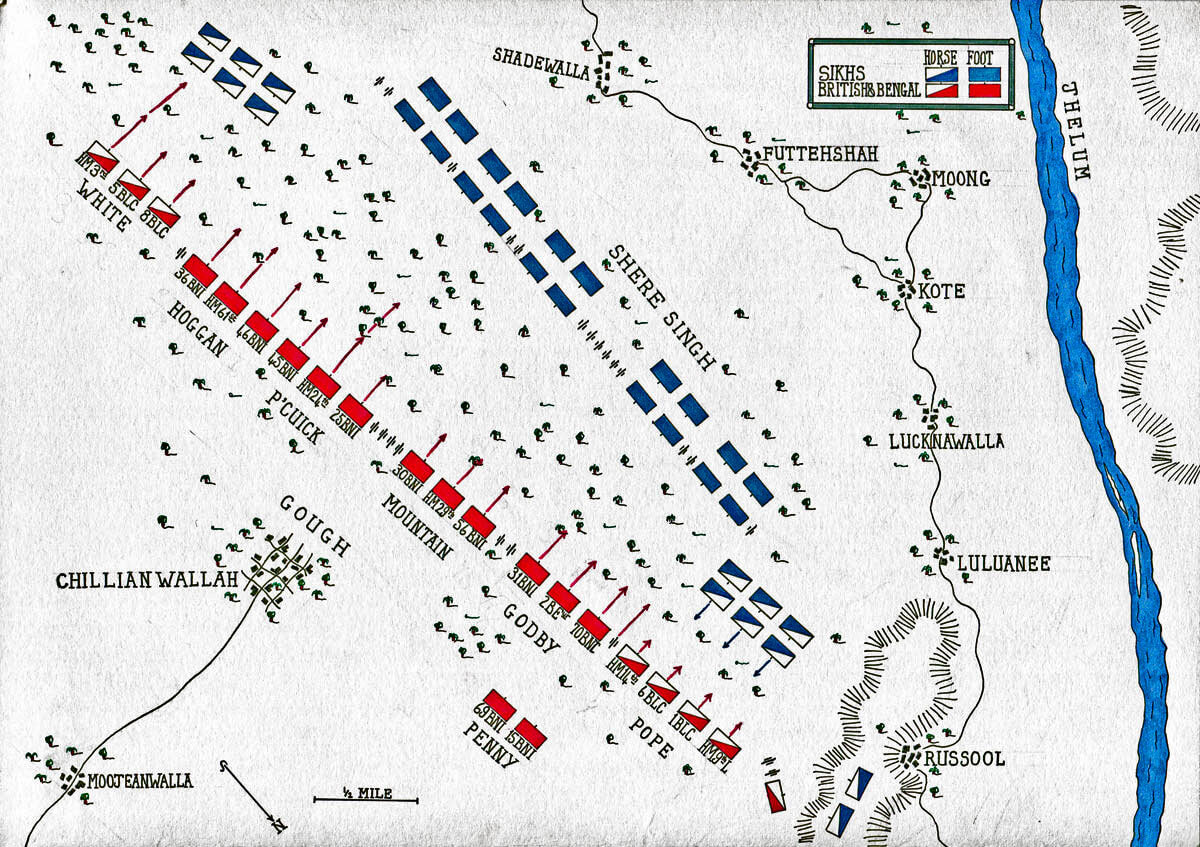
Map of the Battle of Chillianwallah on 13th January 1849 during the Second Sikh War: map by John Fawkes
Account of the Battle of Chillianwallah:
The Battle of Ramnagar, and General Thackwell’s inconclusive expedition across the Chenab River, had the effect of driving Shere Singh’s Sikh army north from the Chenab, to take up a position against the River Jhelum. On 10th January 1849, the news came in to the British commander, Major General Gough, that the Sikh commander, Chattar Singh, had finally captured the fortress of Attock in the extreme north-west corner of the Punjab. It was now a matter of time before Chattar Singh’s force, with its Afghan allies, joined Shere Singh on the Jhelum to create an overwhelming Sikh army.
The Governor General, Lord Dalhousie, urged General Gough to advance with the British and Bengal ‘Army of the Punjab’ and attack Shere Singh before he could be reinforced.
The fall of the city of Multan to its British and Bombay Presidency besiegers released General Whish’s division to re-join the Army of the Punjab, but Dalhousie and Gough took the view that they could not wait for its arrival.
On 13th January 1849, Gough marched up to within eight miles of the Sikh army in its position along the Jhelum River, entrenched in a row of rural hamlets. The Army of the Punjab halted at the village of Chillianwallah and prepared to pitch camp, while Gough carried out a reconnaissance.
The Sikh left flank lay on the village of Rasul, in a line of small hills running nearly parallel with the Chenab River. The Sikh right lay against a thick jungle wall. Along the front of the Sikh line was a deep area of scrubby jungle.
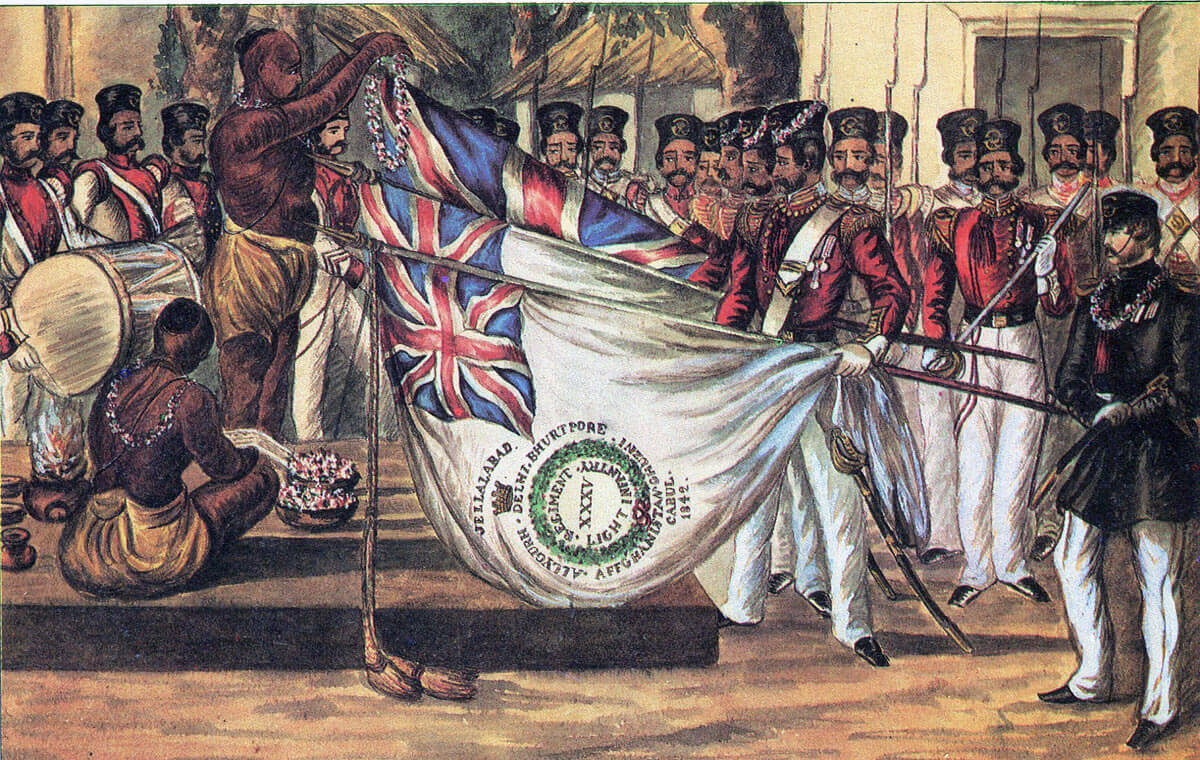
Bengal Native Infantry blessing their colours before the Regimental Brahmin: Battle of Chillianwallah on 13th January 1849 during the Second Sikh War
The Sikh army comprised 25 infantry battalions, of which 10 had been raised since the end of the First Sikh War, 5,000 Gorcharra irregular cavalry and 65 guns, mostly of a light calibre. It was a feature of the Second Sikh War that the Sikhs had lost the predominance in size and numbers of guns they had possessed in the First Sikh War.
Pitching camp by the Army of the Punjab was interrupted when a battery of Sikh artillery advanced and opened fire on the British and Bengalis, until they were forced to retire by the counter-fire of Gough’s artillery. The whole of the Sikh artillery came into action and it became clear that the Sikhs had advanced well forward from their fortified position and that battle was imminent.
Cancelling the order to pitch camp, Gough formed up his regiments and prepared for battle, while his guns returned the Sikh fire.
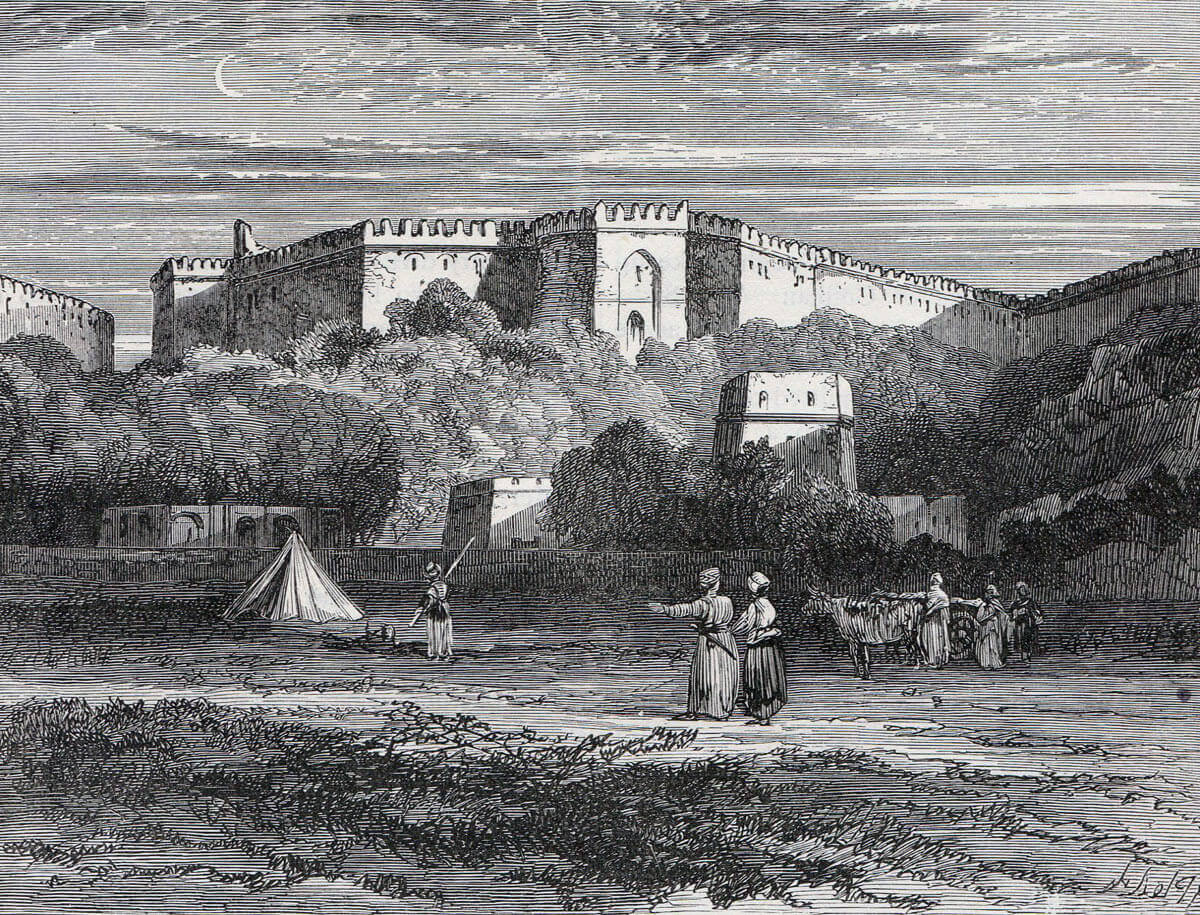
Fort Rhotas, Chillianwallah: Battle of Chillianwallah on 13th January 1849 during the Second Sikh War
It is reported that Gough was particularly enraged when several Sikh cannon rounds came the way of his staff. The criticism is made that it would have been better to have acted with restraint and stuck to his plan to give battle the next day.
Gough drew up his infantry in two divisions of two brigades each: from the left; Campbell’s division of Hoggan’s and Pennycuick’s brigades, then Gilbert’s division of Mountain’s and Godby’s brigades. Penny’s brigade provided the infantry reserve. White’s cavalry brigade was posted on the left flank with Pope’s cavalry brigade on the right.
The dense scrub made movement and observation equally difficult and, as always in battles in the Indian plains, the marching of troops and horses and the firing of artillery and infantry weapons created heavy clouds of dust and powder smoke which added to the confusion.
Horsford’s heavy guns fired upon the centre of the Sikh position, aided by the field batteries positioned on the flanks of the army. After an hour of bombardment, the infantry was ordered forward to attack.
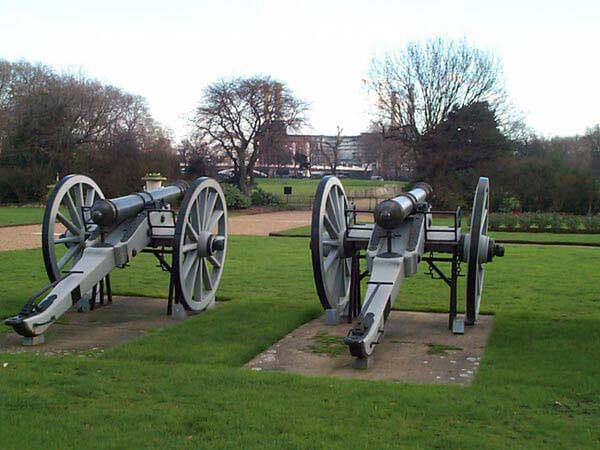
Sikh guns captured at the Battle of Chillianwallah on 13th January 1849 during the Second Sikh War and now in Chelsea Hospital in London
In Campbell’s division on the left, Hoggan’s brigade pushed into the Sikh infantry line and drove it back. Pennycuick’s brigade drifted away to the right, struggling to keep order in the dense scrub. HM 24th Foot, an inexperienced British regiment full of young soldiers, outstripped its two flanking BNI battalions and reached the Sikh lines, attacking and overrunning the Sikh positions, taking many guns.
The Sikhs stormed back into the captured trenches in overwhelming numbers, and drove the disordered 24th Foot out in full retreat and with heavy casualties. The two BNI battalions attempted to hold the attack but were forced back, the whole brigade retreating in confusion to its start point.
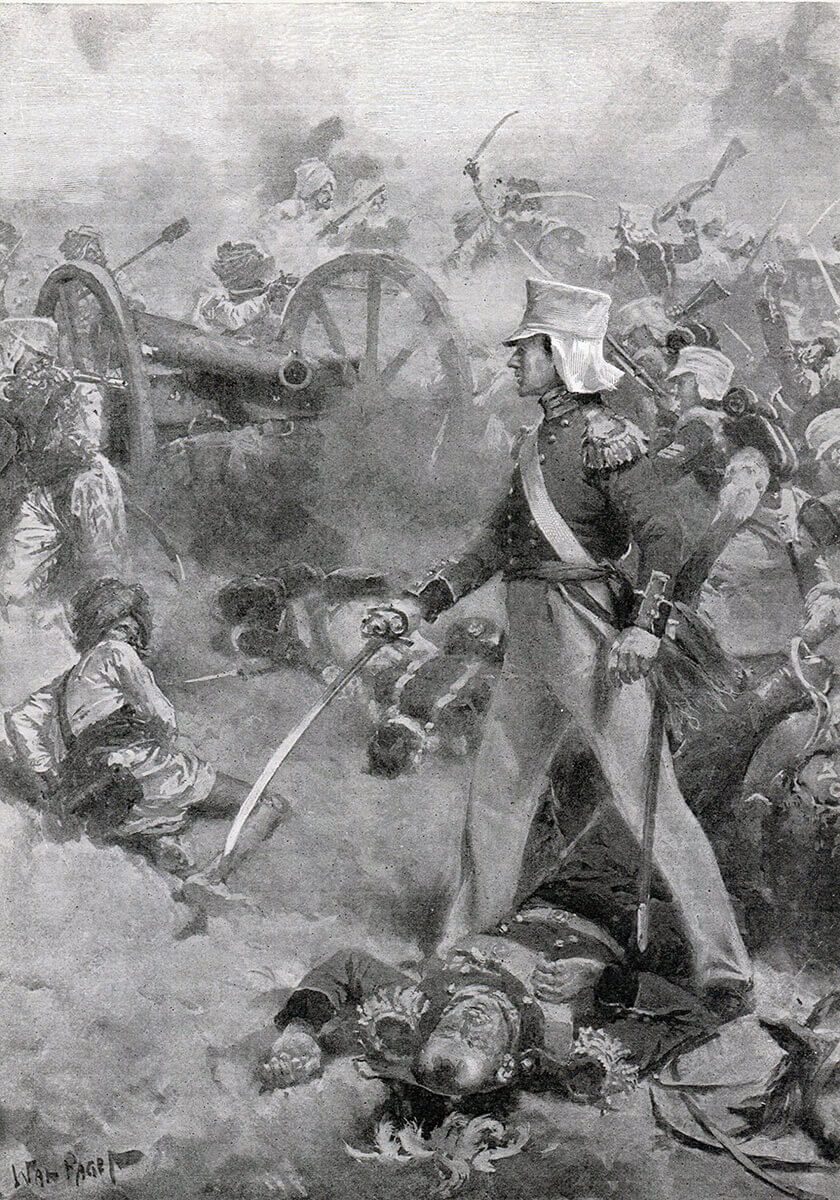
Brigadier Pennycuick’s body defended by his son at the Battle of Chillianwallah on 13th January 1849 during the Second Sikh War: picture by Wal Paget
In the melee, Brigadier Pennycuick, his son, Lieutenant Colonel Brookes, the commanding officer of the 24th, and the two other field officers of the regiment were killed. The 25th and 45th BNI lost all but one of the five colours these two regiments carried. HM 24th Foot lost one colour while the other was rescued by a private soldier. Penny’s brigade advanced into the gap left by the retreat of Pennycuick’s and managed to hold the Sikh pursuit.
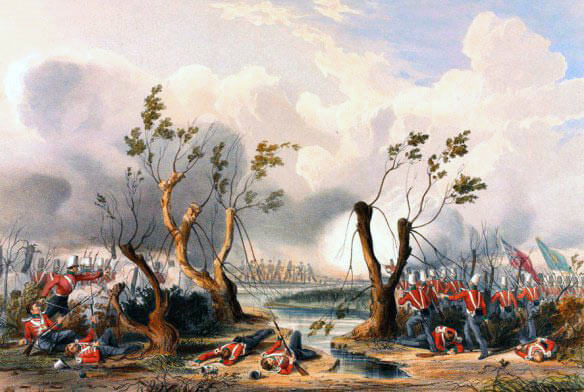
British infantry attacking at the Battle of Chillianwallah on 13th January 1849 during the Second Sikh War
Hoggan’s brigade, under General Campbell’s leadership, pushed through the strip of jungle behind the Sikh lines, supported by the fire of horse and field batteries, coming out on the far side in the presence of a strong force of Sikh infantry, cavalry and guns. HM 61st Foot charged the body of cavalry and drove them away, while the Sikh infantry repulsed the 36th BNI on their right. HM 61st wheeled and attacked the Sikh infantry and two guns they had brought up. On the left of the brigade 46th BNI repulsed a Sikh cavalry charge. The whole brigade formed to its right and advanced down the Sikh line, rolling it up and capturing 13 guns until they joined up with Gilbert’s Division.
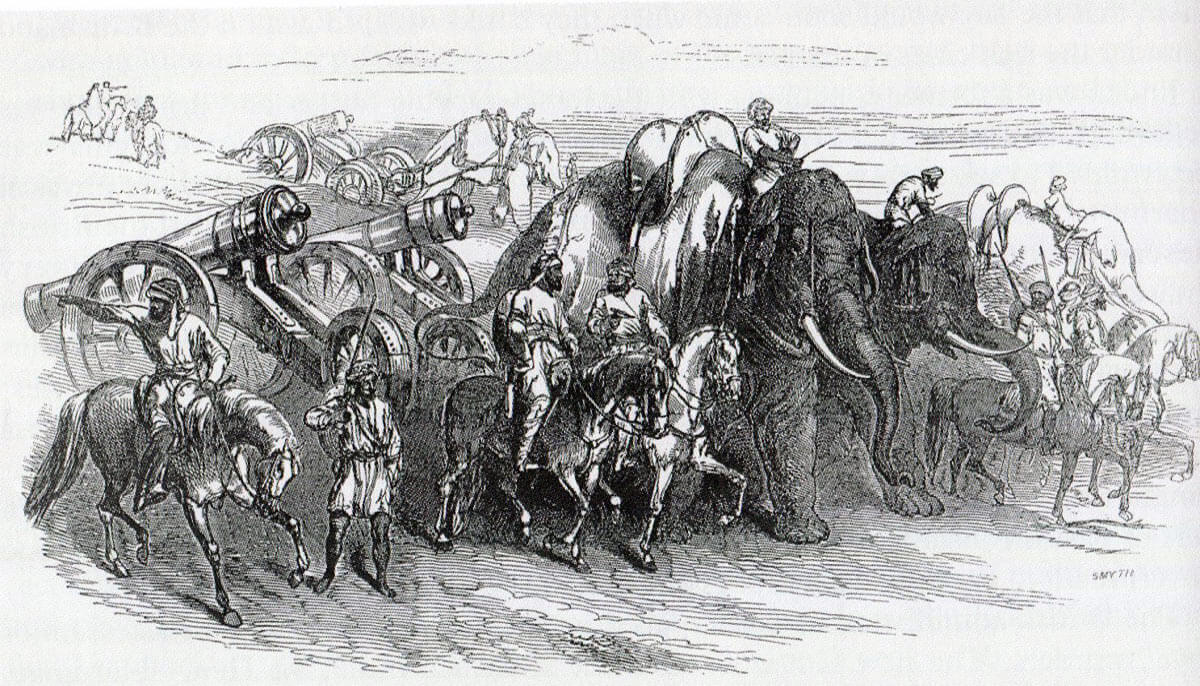
Sikh guns pulled by elephants: Battle of Chillianwallah on 13th January 1849 during the Second Sikh War
On the left flank, White’s cavalry brigade found itself confronted by a large force of Sikh Gorcharra irregular horsemen. Captain Unett of the 3rd King’s Own Light Dragoons led his squadron into the charge, galloping as best they could through the broken jungle. General Thackwell, the commander of the cavalry division, ordered the 5th BLC up in support, but the regiment failed to follow Unett’s squadron into the dense mass of Gorcharras. Unett’s light dragoons cut their way through the Sikhs and, turning, charged back, dispersing the threat to the left flank. All the officers of the squadron were wounded.
On the right flank, Pope directed his brigade to advance in line of regiments; two squadrons of HM 9th Lancers on the right (the remaining two squadrons had been sent away towards the hills), three squadrons of 1st and 6th BLC in the centre and HM 14th King’s Light Dragoons to their left, with ten guns of Huish’s and Christie’s troops of Bengal Horse Artillery on the extreme left of the brigade. No unit was retained as a supporting line.
Pope led his brigade at the trot through the broken scrub, without the precaution of skirmishers in advance. At the sight of a body of Sikh cavalry, the BLC squadrons in the centre of the line halted, forcing the British regiments on the flanks to stop in conformity. The Sikhs charged the BLC squadrons which turned about and made off. The two British regiments did the same, all attempts by the officers to halt their soldiers being to no avail.
The precipitous withdrawal of the cavalry regiments left the brigade horse artillery battery unprotected, and, in the confusion of limbering up, the battery was overrun by the Sikh cavalry who captured two guns. Eventually two other guns came into action and were sufficient to drive the Sikh cavalry back.
The retreating cavalrymen from Pope’s brigade found their way back to the camp at Chillianwallah, where they were rounded up by officers of the non-combatant services, including a padre.
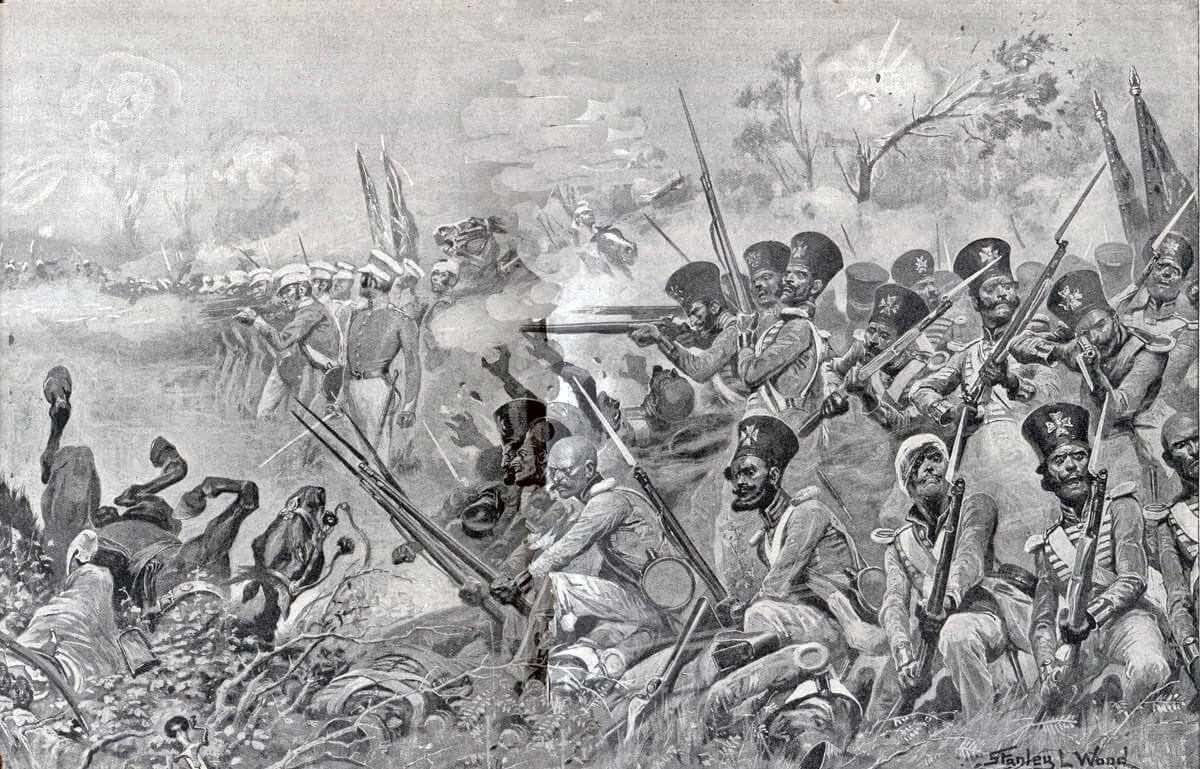
Godby’s brigade assailed by the Sikhs at the Battle of Chillianwallah on 13th January 1849 during the Second Sikh War: picture by Stanley L. Wood
The disappearance of the cavalry left Godby’s infantry brigade exposed. The 70th BNI pulled back its right wing to provide cover and, after some hard fighting, the division was able to resume its advance, Mountain’s brigade taking a Sikh battery.
The battle ended with darkness. The Sikh army left the field, withdrawing into the hills around Russool, between their position and the Jhelum River. Gough’s army withdrew to the village of Chillianwallah, leaving several guns on the field, but ensuring they were spiked.
Heavy rain set in the next day preventing any further manoeuvre by either side.
Casualties at the Battle of Chillianwallah:
From Pennycuick’s brigade; HM 24th Foot suffered 518 casualties (14 officers and 241 men killed and 10 officers and 266 men wounded), probably out of 1,000 effectives; 25th BNI suffered 211 casualties and 45th BNI suffered 79 casualties.
From Unett’s squadron of HM 3rd King’s Own Light Dragoons of 106 men, only 48 were in the saddle at the end of the battle.
Brigadier Pope was mortally wounded in the battle. The 14th King’s Light Dragoons had one officer killed, a son of Brigadier Cureton, himself killed at the Battle of Ramnagar.
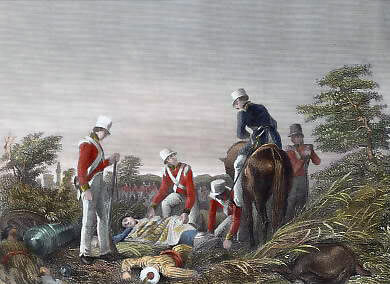
Finding the missing 24th Regiment’s colour after the Battle of Chillianwallah on 13th January 1849 during the Second Sikh War
Follow-up to the Battle of Chillianwallah:
General Gough, with perhaps uncharacteristic restraint, resisted all urgings to attack the army of Shere Singh in his new position, waiting until shortage of supplies forced the Sikh army to move into more fertile and open country. Reinforcements reached Shere Singh from Attock, but so did reinforcements for the Army of the Punjab from Multan, and in time for the finale of the war at the Battle of Goojerat.
Anecdotes and traditions from the Battle of Chillianwallah:
- The British press and public were horrified by the losses and the apparent incompetence of the leadership at the Battle of Chillianwallah. The Government decided that Gough was to be replaced as commander-in-chief by the elderly veteran Lord Napier, but the war ended with the successful Battle of Goojerat before Napier reached India.
- The cause of the collapse of Pope’s cavalry brigade was attributed to Pope’s age and inexperience. He was elderly and so ill that he had to be helped to mount and had never commanded more than a squadron in the field.
- Chillianwallah was an iconic battle for the British cavalry for widely differing reasons. Unett’s charge with his squadron of the 3rd King’s Own Light Dragoons on the left flank was held up as a paragon. The squadron was mounted entirely on greys. The conduct of Pope’s brigade on the right flank became notorious. It is said that the slur cast on the competence and courage of the British light cavalry continued to reverberate into the Crimean War, and may have contributed to the disastrous Charge of the Light Brigade. Captain Nolan, who played such a key part in committing the Light Brigade to the charge at the Battle of Balaclava, was serving in India with the 15th Hussars during the Sikh Wars, and was appalled by the incompetent handling of Pope’s cavalry brigade at Chillianwallah.
- An extraordinary incident took place in 1850, when Sir Charles Napier reviewed the 3rd and 14th Light Dragoons and congratulated them on their performance in the Sikh Wars. A trumpeter of the 14th rode forward and announced to Napier ‘Our colonel is a coward,’ referring to the commanding officer, Lieutenant Colonel King. Soon afterwards King shot himself. At the point during the Battle of Chillianwallah when Pope’s cavalry brigade began to disintegrate, King was attempting to persuade Pope to charge the Sikh cavalry.
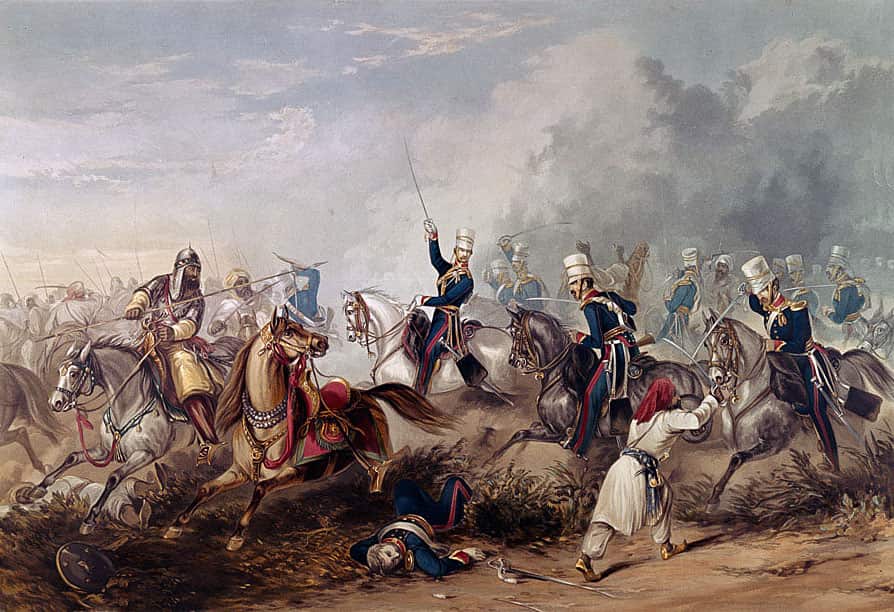
Captain Unett leading the ‘Greys’ Squadron of the 3rd King’s Own Light Dragoons at the Battle of Chillianwallah on 13th January 1849 during the Second Sikh War
- Captain Unett led the ‘Greys’ squadron of HM 3rd King’s Own Light Dragoons at the Battle of Chillianwallah. On the regiment’s return to England, Captain Unett and Lieutenant Stisted, both wounded in the battle, were presented to Queen Victoria to be congratulated on their conduct.
- HM 3rd King’s Own Light Dragoons: It is hard not to rhapsodise over the conduct of the ‘Galloping Third’ in the Sikh Wars. The regiment charged several times at each of the Battles of Moodkee, Ferozeshah, Sobraon, Ramnagar, Chillianwallah and Goojerat. In many instances, the charges were delivered when regiments of Bengal Light Cavalry baulked at clashing with the feared Sikhs, leaving the 3rd to attack unsupported and against overwhelming odds, the officers and soldiers knowing the Sikhs gave no quarter and inflicted appalling wounds with their razor sharp kirpan swords, severing limbs and heads.
- Farrier Johnson, a member of Unett’s squadron, was killed in the battle. His dog, Albert, remained with his master’s body for two days, until it was buried. Albert can be seen in the bottom right corner of the second picture.
- Gough, on hearing of the conduct of the padre in halting and calming the retreating cavalrymen from Pope’s brigade, wanted to promote him bishop, but was told that he did not have the authority to make promotions in the church.
- One of the casualties in White’s cavalry brigade was the Subedar-Major of the 8th Bengal Light Cavalry, a man aged 78 with over 60 years’ service in the Bengal Army.
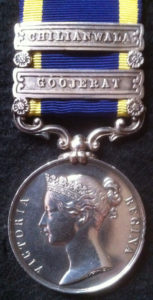
Punjab Campaign, 1848-9 Medal: Battle of Chillianwallah on 13th January 1849 during the Second Sikh War
Medals and decorations:
British and Indian soldiers who took part in the Second Sikh War received the silver medal entitled ‘Punjab Campaign, 1848-9’.
Clasps were issued for the battles (or in the case of Mooltan the siege) which were described as: ‘Mooltan’, ‘Chilianwalah’, and ‘Goojerat’.
Description of the medal:
Obverse. -Crowned head of Queen Victoria. Legend: ‘Victoria Regina.’
Reverse. -The Sikh army laying down its arms before Sir W.R. Gilbert and his troops near Rawal Pindi. Inscription ‘To the Army of the Punjab.’ In exergue ‘MDCCCXLIX.’
Mounting. -Silver scroll bar and swivel.
Ribbon. -Dark blue with two thin yellow stripes, 1 ¼ inch wide.
References for the Battle of Chillianwallah:
History of the British Army by Fortescue.
History of British Cavalry by the Marquis of Anglesey.
The Galloping Third by Hector Bolitho
The previous battle in the Second Sikh War is the Battle of Ramnagar
The next battle in the Second Sikh War is the Battle of Goojerat
